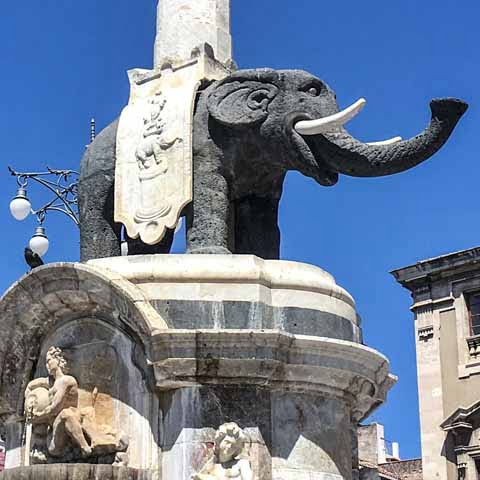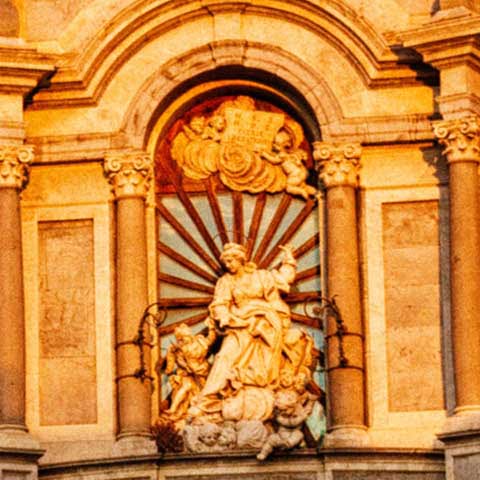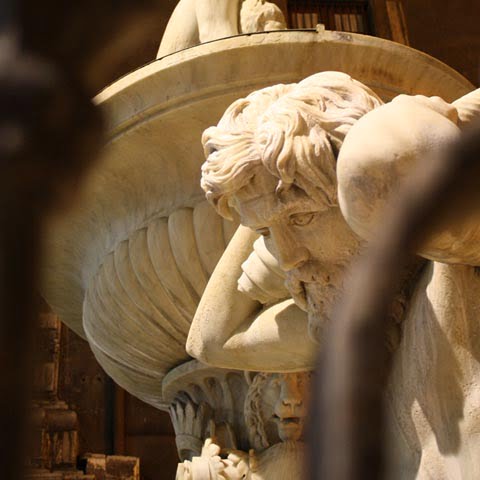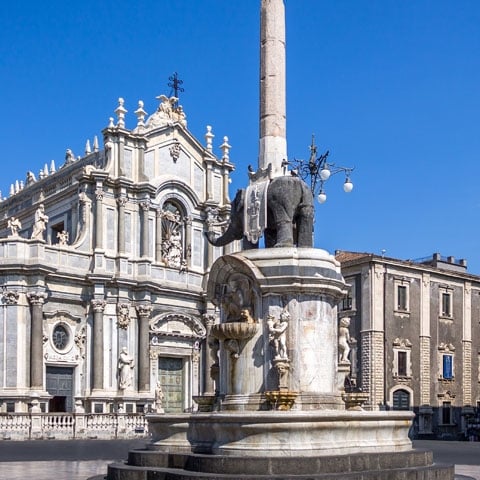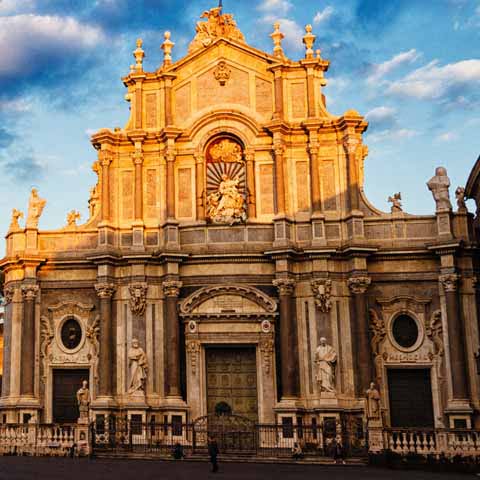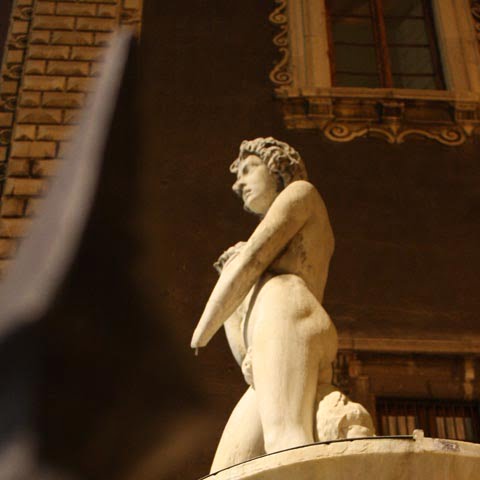Located on picturesque Sicily, Catania is the island’s second largest city and the main hub for the eastern part of the island. Originally founded by the Greeks, Catania’s roots can be traced back to the Paleolithic Period. Sicily flourished during the Renaissance becoming a center of culture not only for the island, but for Italy as a whole. Over the centuries, the city also became the home of revered writers, such as Giovanni Verga and Federico De Roberto, and famed composers, including Vincenzo Bellini and Giovanni Pacini.
The city is located at the base of Mount Etna, and this location has greatly shaped the city’s history and present appearance. Catania has been damaged by several devastating volcanic eruptions and earthquakes over the centuries, particularly during the seventeenth century. Following the 1693 earthquake, Catania’s buildings were rebuilt in Sicilian Baroque style, which to this day remains one of the city’s defining features and has garnered recognition from UNESCO.
Today, in addition to its architecture, Catania’s characteristic cuisine, including its distinct street food tradition, as well as the city’s art and musical legacy have made Catania one of Sicily’s principal tourism centers.
PREHISTORY OF CATANIA
Catania was founded by the Greeks during the eighth century BC. Its history is rich in cultural heritage from the many different conquerors of Sicily over the millennia including the Greeks, Romans, Byzantines, Arabs, Normans, Swabians, Angevins, Aragonese and Spaniards. Countless historic monuments attest to this heritage from the Roman Amphitheater to the Baroque churches.
According to some historians, the presence of man in Sicily dates back to the Paleolithic Period, approximately one million years ago.
At the summit of the hill occupied today by Piazza Dante and the grandiose Benedictine Monastery of San Nicolò l’Arena, traces of inhabitants of the site from the prehistoric period have been discovered, especially relating to the Neolithic and the Copper Ages.
According to historians, Catania was founded in 729 BC by Greek colonists. To corroborate this thesis, Greek structures and materials have been found inside the Ursino Castle, in an area that in ancient times was closer to the sea than it is currently. These artifacts date back to the period between the end of the eighth and the beginning of the seventh century BC, and are attributable to the original phase of the colony of Catania. Remains of the ancient city continue to emerge from the subsoil.
The toponym of Catania derives from katàne, which means “grater” and refers to the lava soil on which the city stands.
In 476 BC the city was conquered by the Syracusan tyrant Hiero I who renamed it Aitna (Etna). in 461 BC, however, after the fall of the Syracusan tyranny, the ancient name was restored.
During the second half of the fifth century, when the the great Athenian expedition to Sicily unfolded (415-413 BC), the inhabitants of Catania lined up on the side of the Attic city.
A decade after the Athenian defeat, in 403 BC, Catania was conquered by the Syracusan tyrant Dionysius the Great who partly sold the inhabitants as slaves.
After these events, in the fourth century and in the first decades of the third, Catania remained under Syracusan power.
Catania was conquered by the Romans in 263 BC, at the beginning of the First Punic War. For 700 years the prestige and importance of the city grew. The extremely fertile volcanic soil was a source of wealth for the city, which flourished again.
Under Roman rule Catania was part of the Roman province of Sicily. Many buildings, such as the Roman theater, the amphitheater, and the thermal baths are evidence of a flourishing of the city during the Roman Empire.
HISTORY OF CATANIA
The city became an Episcopal seat in the third century AD. Catania experienced phases of decline in the fifth and sixth centuries due to the invasions of Vandals and Goths. In 975, the city was occupied by the Arabs.
The Norman conquest took place in 1071. The Altavilla, one of the most important Norman families, favored the return to Christianity and the spread of Latin monasticism. The foundation of the Benedictine Abbey of Sant’Agata dates back to this period. The first abbot was the Breton Angerio, who, in 1092, was consecrated bishop of the restored episcopal see.
In 1169, an earthquake destroyed the city and caused fifteen thousand victims. In 1179, the Catanesi suffered the repression of Holy Roman Emperor Henry VI.
From 1209 to 1210, Frederick II of Swabia and Constance of Aragon transferred the court to Catania to avoid the plague that broke out in Palermo. The city then passed to the Angevins.
In 1282, Catania passed to the Crown of Aragon. After annexation to the Kingdom of Aragon, Sicily lost its independence and passed under the Spanish.
The history of the Aragonese in Sicily begins immediately after the Sicilian Vespers. During the Vespers, the Sicilians drove the French off the island while asking for the help of Peter III of Aragon by offering him the Crown.
Peter I the Great, the husband of Constance II, was the last heir of the Swabian dynasty and was beloved by the Sicilians. He was crowned Peter I of Sicily in Palermo and reigned in Sicily together with his consort Constance.
Peter I was succeeded by his son James II of Aragon, who was crowned James I of Sicily. In 1294, James returned Sicily to the Anjou in exchange for Sardinia and Corsica.
The Sicilians did not like this pact. At the end of 1295, the Sicilian parliament met and declared James unfit to rule. His younger brother Frederick III was selected to rule.
The Sicilians had driven out the French during the Vespers ten years earlier and they did not agree to be ceded again to the Anjou.
With Frederick III, the War of the Vespers officially ceased and with the Peace of Caltabellotta Frederick III proclaimed himself King of Sicily. Subsequently, Frederick III himself married the daughter of Charles II of Anjou and the disputes to ceased completely.
Frederick’s successor was his eldest son Peter II of Sicily. With the Peace Treaty of Catania, the Anjou officially renounced all claims on the island.
Sicily was ruled directly by the kings of Spain via governors and viceroys. In the ensuing centuries, authority on the island became concentrated among a small number of local barons. The last king of the Aragon dynasty was Ferdinand II who ruled Sicily until 1516.
The sixteenth century was a golden age for Sicily. Inflation, rapid population growth, and international markets brought economic and social changes.
During the seventeenth century, Sicily’s silk exports overtook its wheat exports.
Internal colonization and the foundation of new settlements by feudal aristocrats in Sicily was significant from 1590 to 1650, involving the redistribution of the population away from the larger towns back to the countryside.
The baronage took advantage of increasing population and demand to build new estates, based mostly on wheat. The foundation of estates was a means towards social and political prominence for many families.
The eruption of Mount Etna in 1669 and a terrible earthquake in 1693 destroyed much of the historical and artistic evidence of the past. These two natural events marked the transit towards modernity.
The post-earthquake reconstruction was characterized by the Baroque style. Though the Ursino Castle remained intact in its original form, other ancient buildings were renovated and rebuilt with the new eighteenth-century style. Great examples include the Cathedral of Sant’Agata, the Monastery of San Nicolò l’Arena, and the Palazzo degli Elefanti as well as several other churches and monasteries.
Afterwards, Catania passed to the Savoy. In 1734, the Austrian Hapsburgs led the union with the Bourbon-ruled Kingdom of Naples under the rule of Don Carlos of Bourbon, and later Charles III of Spain.
The Bourbon administrative reform of 1817 established seven equal provinces in Sicily. The hierarchy among the Sicilian cities was redefined and Catania found itself the capital of a vast territory, acquiring the status of Municipality.
In 1860 Catania became part of the Unified Kingdom of Italy. Between 1850 and 1900 Catania was the scene of a strong demographic growth with agriculture is the basis of Catania’s wealth. This period also saw the construction of theaters, cultural centers, universities, and academies.
With the second half of the century, the railway also arrived, and with it the connection with the two goods that would serve as the foundation of a great expansion: sulfur and citrus fruits.
With the World Wars, commercial circuits were broken and Sicilian sulfur lost its importance. As a result, the city entered a deep crisis, from both a social and economic perspective.
Catania, however, was able to respond to the crisis with a new approach to trade, focusing on construction and architecture. Nowadays, the Baroque city center is a UNESCO World Heritage Site full of artistic and historic gems.
ARCHAEOLOGY OF CATANIA
Piazza Dante was the place where, around the eighth century BC, the acropolis of the Greek Katàne was built, the center of religious and political life, which was followed by the residential buildings and roads of the Roman city. The archaeological complex of the theater is an important testimony of this past.
In Piazza Dante you can see walls that belonged to a private domus, dating back to the Imperial Roman Era.
Of interest are the Achillane Baths, whose name has been deduced from the fragments
of a marble slab datable to the first half of the fifth century.
The Roman Amphitheater of Catania, probably built in the 2nd century AD, is the largest of all the amphitheaters in Sicily. It is believed to have once held approximately 15,000 seated spectators.
Precious testimonies of Greek and Roman Catania are collected in the Archaeological Museum of the city. Here objects and finds are arranged according to a timeline from Prehistory to the Middle Ages.
Don't just see Italy, live it.
Your dream trip to Italy has never been closer
No more endlessly scrolling travel sites. Our travel experts will craft the perfect, one-of-a-kind trip just for you.

300+
DESTINATIONS
We offer more Italian destinations than any travel site. Do and see more with Trips 2 Italy.
1 (of a kind)
ITINERARIES
Because your dream trip to Italy should be designed for you, not for the masses.
100%
PEACE OF MIND
From flights and accommodations, to food and activities - we take care of every detail.
